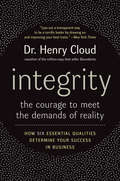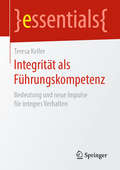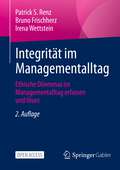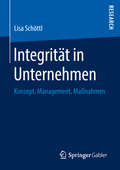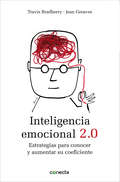- Table View
- List View
Integrity: The Courage to Face the Demands of Reality
by Henry CloudIntegrity--more than simple honesty, it's the key to success. A person with integrity has the ability to pull everything together, to make it all happen no matter how challenging the circumstances. Drawing on experiences from his work, Dr. Henry Cloud, a clinical psychologist, leadership coach, corporate consultant and nationally syndicated radio host, shows how our character can keep us from achieving all we want to (or could) be. In Integrity, Dr. Cloud explores the six qualities of character that define integrity, and how people with integrity: Are able to connect with others and build trust Are oriented toward reality Finish well Embrace the negative Are oriented toward increase Have an understanding of the transcendent Integrity is not something that you either have or don't, but instead is an exciting growth path that all of us can engage in and enjoy.
Integrität als Führungskompetenz: Bedeutung und neue Impulse für integres Verhalten (essentials)
by Teresa KellerIn diesem essential zeigt Teresa Keller, wie integres Verhalten entwickelt und dauerhaft aufrechterhalten werden kann. Die Autorin verdeutlicht die Bedeutung sowie Wirkung von Integrität und erläutert Faktoren wie Achtsamkeit, Haltung, Anstand und emotionale Intelligenz, die maßgeblich an Integrität beteiligt sind. Vor allem aber macht sie die Relevanz von Integrität als Führungskompetenz klar – zu oft wird Integrität als nachrangiges Führungs- und Unternehmensziel behandelt.
Integrität im Managementalltag: Ethische Dilemmas im Managementalltag erfassen und lösen
by Patrick S. Renz Bruno Frischherz Irena WettsteinGeschenke und Gefälligkeiten, Entlassungen, Mobbing, Billiglohnproduktion oder Einsatz von Cookies oder Persönlichkeitsprofilen – Das Spektrum an möglichen Spannungsfeldern im Unternehmensalltag ist groß. Mit der Digitalisierung sind die ethischen Herausforderungen noch größer. Dieses Open Access Buch führt Führungskräfte in die Erfassung und Lösung ethischer Dilemmas im Unternehmensalltag ein. Praxisnah und konkret stellt es sieben Leitideen als ethisches Fundament und ein Ablaufschema zur Lösung ethischer Dilemmas vor. 32 häufige Spannungsfelder werden anhand von kurzen Fallbeispielen analysiert und diskutiert. Das Buch präsentiert zudem einfache, aber auch umfassende Good Practices eines modernen Integritätsmanagements. In Zeiten, in denen der Ruf nach der Wahrnehmung von sozialer, gesellschaftlicher und digitaler Verantwortung von Unternehmen immer lauter wird, gibt dieses Lehrmittel den Führungskräften einen Leitfaden an die Hand, wie sie ethische Dilemmas im Unternehmensalltag strukturiert angehen können.Die zweite Auflage enthält ein völlig neues Kapitel mit sieben Fallbeispielen zur Corporate Digital Responsibility (CDR), das heißt, zur Verantwortung von Unternehmen im Zeitalter der Digitalisierung. Der InhaltGrundbegriffe der EthikSpannungsfelder in OrganisationenEthische DilemmasLeitideen guter ZusammenarbeitFallbeispiele zum IntegritätsmanagementFallbeispiele zur Corporate Digital Responsibility (CDR)Good Practices im IntegritätsmanagementDies ist ein Open-Access-Buch.
Integrität in Unternehmen: Konzept, Management, Maßnahmen
by Lisa SchöttlUnternehmen stehen in der Verantwortung, eine Vielzahl an Werten in ihrem Geschäft zu beachten, allen voran den der Integrität. Das Buch beantwortet die Frage, was Integrität für Unternehmen bedeutet und wie integres Unternehmenshandeln erreicht werden kann. Die Autorin entwickelt einen theoretisch fundierten und praktisch anwendbaren Ansatz der Unternehmensintegrität und gibt Orientierung, wie dieser durch vielfältige Maßnahmen im Rahmen von Integrity Management umgesetzt werden kann. Dabei werden klassische Compliance-Ansätze um eine werteorientierte Perspektive ergänzt, damit Unternehmen ihre je eigene Verantwortung wahrnehmen können.
Integrität in der Führung: Erfolgreiches Leadership durch Persönlichkeit und Werte
by Peter Hügelmeyer Anne GlögglerIntegrität der Führungspersönlichkeit als zentraler Erfolgsfaktor für Unternehmens- und MitarbeiterführungMitarbeiter- und Unternehmensführung ist von Zielkonflikten, Veränderungen und Mehrdeutigkeiten geprägt. In dieser komplexen Situation ist Integrität der Schlüsselbegriff für erfolgreiches Leadership. Eine integre Führungspersönlichkeit reflektiert ihre Werte regelmäßig und hinterfragt ihre Haltung und ihre Handlungen. Konkret äußert sich integres Verhalten in einer hohen Personenorientierung, d. h. der Mitarbeitende steht als Mensch im Zentrum des Handelns und wird bei Entscheidungen aktiv einbezogen. Auf der Unternehmensebene sind es praktizierte Solidarität, Nachhaltigkeit und das Gemeinwohl. Lang bekannte Prinzipien erleben eine ungeahnte Renaissance in der modernen Führung. Zudem ist eine kontinuierliche Weiterentwicklung der Mitarbeitenden und der eigenen Organisation essenziell.Das Buch liefert Denkanstöße, macht Führungskräfte begründungssicher und regt zur eigenen Reflexion an. Es enthält viele direkt umsetzbare Tipps, wie in komplexen Situationen agil gehandelt und wie integre Führung konkret praktiziert werden kann.Aus dem Inhalt Integrität in der Führung: Werte, Haltungen und Handlungen erfolgreicher FührungspersönlichkeitenDer Mensch im Mittelpunkt: Persönlichkeit und WertschätzungIntegre Techniken der Mitarbeiter- und UnternehmensführungIntegre FührungskommunikationIntegre Führung in Veränderungs- und EntwicklungsprozessenKonkrete Tipps zur Umsetzung integrer und agiler Führung
Intel 2006: Rising to the Graphics Challenge
by Elie Ofek Willy ShihExamines the evolution of the PC hardware industry over the span of two and a half decades. The open architecture design of the IBM Personal Computer followed by the rapid appearance of clones drove a high level of standardization and modularity in the industry, and value was distributed along the value chain depending on levels of competition and ability to substitute components at each level. On the hardware side two component segments, the microprocessor and the graphics processor unit (GPU), ultimately became the most valuable parts of the chain. The GPU business had settled into a duopoly with Nvidia, Inc. and ATI Technologies (ATI). Intel had dominated the microprocessor segment, but Advanced Micro Devices (AMD) was consistently a thorn in Intel's side. Addresses the prospects of the graphics function becoming integrated with the microprocessor on a single piece of silicon. AMD had just announced the acquisition of ATI and Paul Otellini, Intel's CEO, is faced with the question of what he should do. Should he buy Nvidia, should he continue with his own internal graphics efforts, or should he listen to some of his customers and leave things separate?
Intel Capital, 2005 (A)
by David B. Yoffie Barbara J. Mack Adriana Boden Lee RandAll companies in a technology-intensive industry must worry about the development of their ecosystems and, in particular, the availability and cost of complementary assets. One strategy for promoting complements is to invest in them directly. Explores Intel's strategy to invest in complements through Intel Capital, perhaps the largest corporate venture capitalist in the world. Compares Intel's approach to the approaches of Panasonic, Microsoft, and Texas Instruments and asks how Intel should address its emerging areas of concern in the digital home. To examine and evaluate different strategies for investing in complementary assets.
Intel Capital: The Berkeley Networks Investment
by David Lane Henry W. ChesbroughDiscusses how Intel Corp. uses corporate venture capital to explore new technologies in new markets. Intel combines external investments with internal research and development.
Intel Corp. 2005
by David B. Yoffie Michael SlindBuoyed by strong recent sales growth but humbled by failed strategic bets and other missteps, Intel in 2005 initiated a major reorganization. Under its new CEO, Paul Otellini, the company shifted toward a "platform" model, inspired by the success of its Centrino mobile-computing product. That model led Intel toward development of not just faster computer chips--the historic source of its dominance of the microprocessor industry--but also of products that bundled ingredients in ways that served specific usability needs. To support such products, Intel continued to invest heavily both in manufacturing capacity and new chip technologies. Meanwhile, the company faced strong challenges from competing chip makers, particularly Advanced Micro Devices. Outlines Intel's strategic reorientation, its competitive environment, and several of its key new initiatives. Covers Intel's Itanium server product, its new Viiv platform, its investment in WiMax, and its recent deal with Apple Computer.
Intel Corp.--1968-2003
by David B. Yoffie Ramon Casadesus-Masanell Sasha MattuDescribes three stages in Intel's history: the initial success and then collapse in DRAMs and EPROMs, its transition to and dominance in microprocessors, and its move to become the main supplier of the building blocks for the Internet economy. Allows a rich discussion of industry structure and transformation in DRAMs and microprocessors, creation of competitive advantage and value capture, and sustainability.
Intel Corp.--1968-97
by Gary P. Pisano David J. Collis Peter BotticelliTraces Intel's history and strategy from 1968 to 1997. Examines the company's decision to exit DRAMS and its entry into microprocessors. Focuses on how the company managed to achieve and sustain its competitive advantage in microprocessors, and the threats it faces in the future.
Intel Corp.--1992
by Kenneth A. FrootIntel Corp., the world's dominant designer and manufacturer of microprocessors (the "brains" of the personal computer), has accumulated a large amount of cash (net of debt). Furthermore, it expects to continue to accumulate cash at an unprecedented rate. Has the company grown up to the extent that it can begin disbursing cash to its shareholders? What kind of disbursement policy should it choose? Intel will continue to face competition from imitators of its processors in the future, yet it is not clear whether its cash holdings can or will be a competitive weapon in this competitive battle. The case focuses on financial policy issues and on how they then interact with a very unusual and dynamic form of product-market competition and innovation. Can be used as a one- or two-day exploration of the following issues: complementarity externalities and costs of finance, appropriability of returns on investments, the role of finance in high-tech and rapidly innovating sectors, the strategic uses of cash, analysis of capital structure and cash disbursement policies, the use of financial policy as a competitive weapon, and timing in the sale and purchase of equity-linked instruments.
Intel Corp.: Leveraging Capabilities for Strategic Renewal
by Ashish Nanda Christopher A. BartlettTraces the history of Intel from its earliest days as a technology-driven memory company to its emergence as an increasingly market-focused microprocessor company with emerging systems capabilities. The focus is on the strategic, organizational, and management adaptation that was required to ensure the company's survival in a highly volatile industry. Under the leadership of Andy Grove and Gordon Moore, Intel is able to overlay its R&D base with manufacturing and marketing capabilities that allow it to continually adapt to changes and renew itself.
Intel Labs (A): Photolithography Strategy in Crisis
by Henry W. ChesbroughIntel has evolved a new approach to managing its industrial research, the distributed labs model. The benefits and limits of this model are explored.
Intel Labs (B): A New Business Model for Commercializing Research in Photolithography
by Henry W. ChesbroughIntel deployed a creative business model to commercialize its EUV technology in photolithography. This model assigned intellectual property and machine priority in an industry consortium.
Intel NBI: Image Components Organization
by Willy Shih Thomas ThurstonThe Image Components Organization (ICO) was an internal venture that was part of Intel's New Business Initiatives. It sought to initially develop and sell a high performance integrated CMOS image sensor module for cellular phones. ICO's opening assumptions were that it could combine externally licensed technology with internal design work, and then manufacture using the company's leading edge manufacturing facilities. Initial implementation challenges led to delays and additional engineering work, but as the designated Intel manufacturing site went to full capacity utilization, ICO faced increasing marginalization. This case complements 609-043 Intel NBI: Intel Corporation's New Business Initiatives and 609-102 Intel NBI: Intel Corporation's New Business Initiatives (B). It is one of the failed ventures cited in those cases.
Intel NBI: Intel Corporation's New Business Initiatives (A)
by Willy Shih Thomas ThurstonFor Intel Corporation, the processes and priorities that have made it so successful are difficult to overcome as the company tries to diversify away from its core. The case examines the history and evolution of the New Business Initiatives (NBI) group, as the leader grapples with the questions surrounding why so few of the unit's start-ups actually become significant businesses within Intel's existing divisional structure. While a handful have successfully "graduated" and continue to show high levels of promise, these ventures did not represent truly new and distinct businesses for Intel. Rather they were strongly tied to existing businesses, raising the question of whether NBI had simply become a way for existing divisions to off-load budgetary risk. The case examines what worked, and what didn't, and the challenges posed by transitioning new ventures into the mainstream of the company.
Intel NBI: Vivonic
by Willy Shih Thomas ThurstonVivonic was a start-up that was part of Intel's New Business Initiatives that sought to develop and sell personal health monitoring hardware and software. When it was first funded, Intel was in the midst of record growth and was seeking diversification. But the company lacked domain expertise and the unit faced many challenges working with existing Intel processes while it strove to establish its own. This case complements 609-043 "Intel NBI: Intel Corporation's New Business Initiatives," and 609-102 "Intel NBI: Intel Corporation's New Business Initiatives (B)." It is one of the failed ventures cited in those cases.
Intel Pentium Chip Controversy (A)
by V. G. Narayanan James A. EvansFollowing Intel Inc.'s decision to replace flawed Pentium chips, the company faces revenue recognition choices. Events leading up to IBM's decision to halt shipment of computers that have Intel's microprocessor inside and Intel's decision to replace all the flawed chips are outlined. Intel must decide whether to: make a provision for the costs of replacing the chips, defer recognition of revenue on the flawed chips that it has now agreed to replace, or make no entries on grounds of materiality.
Intel Research: Exploring the Future
by Alan Maccormack Kerry HermanIt is 2004 and David Tennenhouse, the director of Intel Research, is reviewing the organization he has built since 2000. Intel Research was charged with exploring new and disruptive technologies that lay off the "silicon roadmap" that drove most of Intel's R&D efforts. This exploratory research was conducted using an approach that Tennenhouse oversaw during his years at the Defense Advanced Research Project Agency. Predicated on the funding of university grants, internal research efforts, joint labs run with universities, and selective corporate venture investments, the idea was to build a network to give advance warning of important new technologies. In 2004, Tennenhouse was reviewing its performance.
Intel's Pentium: When the Chips are Down (A)
by Stephen A. Greyser Norman KleinIntel, the largest-selling manufacturer of microprocessor computer chips, finds itself in a brand-threatening situation when a flaw is revealed in its top-of-the-line Pentium chip. The story is front-page news for weeks. The company invested tens of millions of dollars in advertising its branded Pentium chip as a high-quality component via the campaign slogan "Intel Inside." Issues include salience of the problem, when Intel knew of the problem, how it was revealed, and what actions should be undertaken. Teaching Purpose: Students analyze consequences of a company miscue that becomes a much bigger story than initially anticipated. Analogies may be made to other company crisis situations involving brands and communications.
Intel: Strategic Decisions in Locating a New Assembly and Test Plant (A)
by Kerry Herman Juan AlcacerIn mid-2005, Intel is examining its options for where to locate its next assembly and test plant. On its short list of potential sites includes locations in China, India, Thailand, and Vietnam. Each country has its own unique benefits and risks related to infrastructure, governance, education, business culture, intellectual property protection, labor markets, experience working with Western firms, and tax breaks and other incentives. Intel's General Manager for Assembly and Test, Brian Krzanich, has to consider all of these factors as well as Intel's criteria for its new facility's location and make his recommendation to the company's board of directors. Which country and location should Intel choose?
Intel: Strategic Decisions in Locating a New Assembly and Test Plant (B)
by Kerry Herman Juan AlcacerIn February 2006, Intel has selected the location for its new assembly and test plant. This case discusses why this location was chosen from the list of possibilities introduced in "Intel: Strategic Decisions in Locating a New Test and Assembly Plant (A)."
Inteligencia emocional 2.0: Estrategias para conocer y aumentar su coeficiente
by Travis Bradberry Jean GreavesLa inteligencia emocional es el factor más importante para el éxito profesional y la excelencia personal. Todos somos conscientes de que la inteligencia emocional es un factor crítico en el éxito profesional y personal. Pero conocer la inteligencia emocional no es lo mismo que saber cómo emplearla para mejorar y avanzar profesionalmente. Inteligencia emocional 2.0 desarrolla un programa paso a paso con 66 propuestas prácticas para potenciar su inteligencia emocional y mejorar cuatro tipos de habilidades básicas: el autoconocimiento, la autogestión, la conciencia social y la gestión de las relaciones. Al mismo tiempo, el libro ofrece al lector la oportunidad de conocer su coeficiente emocional y aprovechar así, de modo individualizado, los consejos de los autores. Los expertos opinan:«La inteligencia emocional es una habilidad muy importante para el éxito personal y profesional. Este libro es excelente, y su método, puntero. Lo recomiendo encarecidamente.»Ken Blanchard, coautor de El directivo al minuto «Este libro proporciona abundantes pautas y recomendaciones para potenciar su inteligencia emocional. Los investigadores han demostrado que el coeficiente emocional es más importante que el coeficiente intelectual.»Stephen R. Covey, autor de Los 7 hábitos de la gente altamente efectiva «Inteligencia emocional 2.0 explica de forma sucinta cómo manejar nuestras emociones con creatividad y emplear nuestra inteligencia de manera positiva.»El Dalai Lama «Si usted desea transformarse en un verdadero líder resonante, este libro le ofrece la posibilidad de cambiar no solo su carrera profesional sino también sus relaciones personales.»Regina Sacha, vicepresidenta de Recursos Humanos, FedEx Custom Critical
